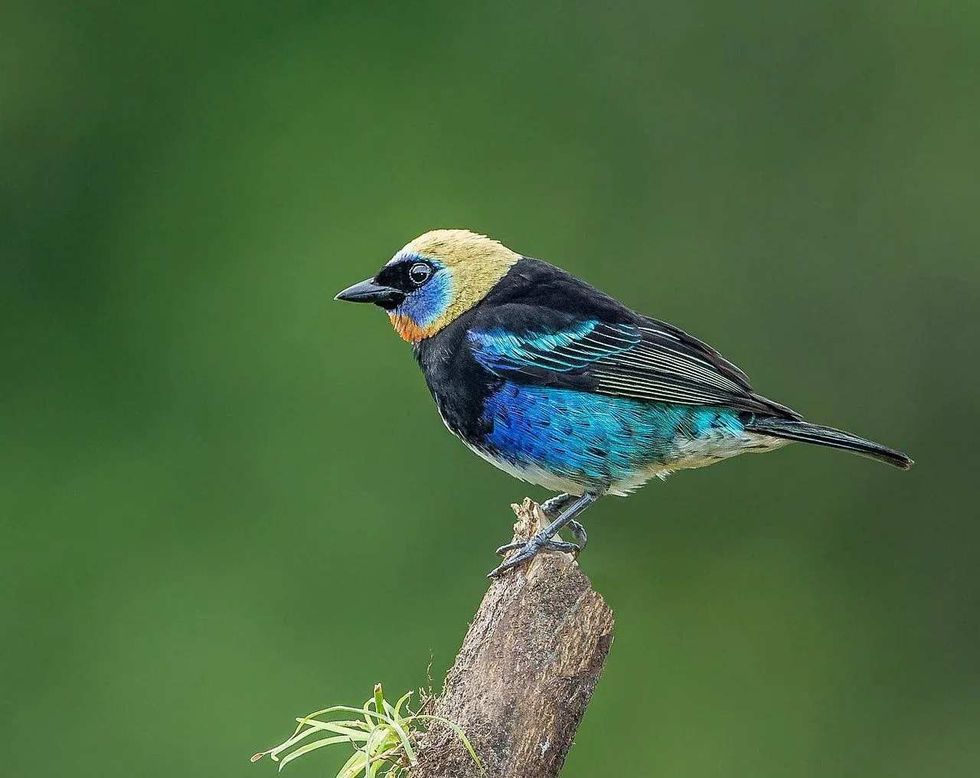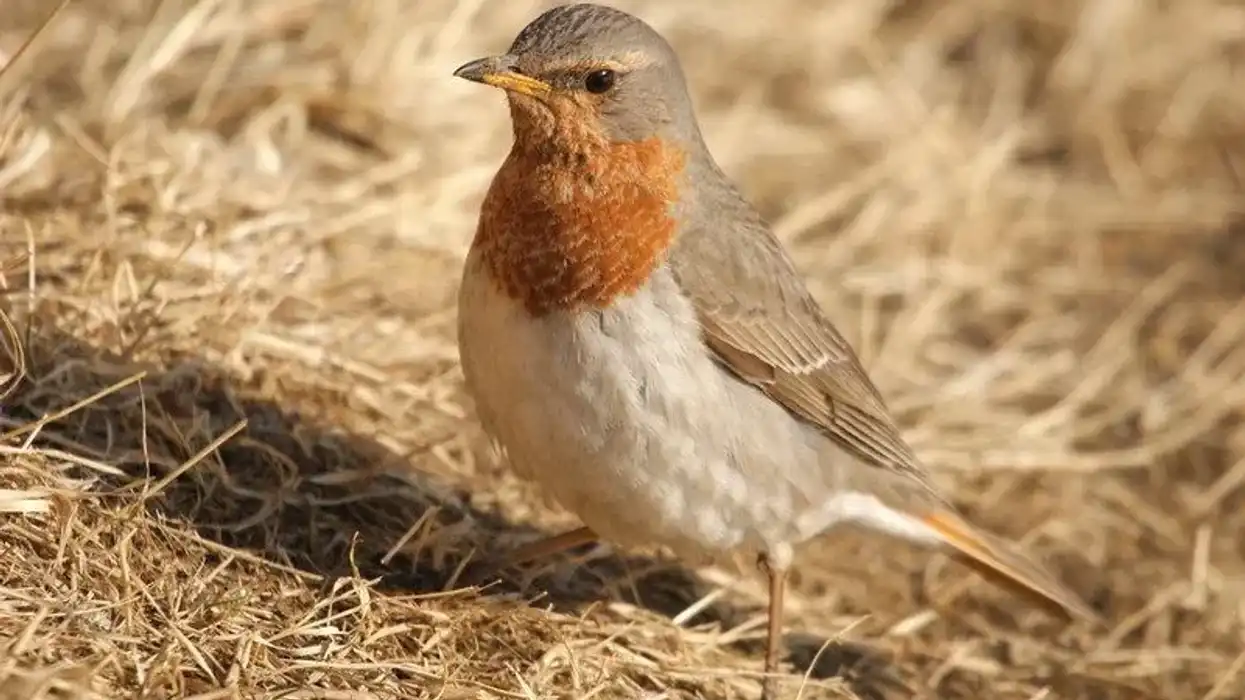The golden-hooded tanager is a colorful and loud tanager species from the Thraupidae family, found exclusively on the American continent. Usually found within dense forests, this bird species is known for its bright blue or turquoise rump and underbelly.
Due to their dense habitat and preference for living at high elevations within forests, little has been observed about their population fragmentation and other habits. During the breeding season, a pair or group of three birds may raise a brood together.
Adult females may lay up to two eggs. Sometimes, even three eggs have been noted in a year. Their nests are made within banana trees with things like dead leaves and cobwebs.
The species is also known to forage along with other bird species. They form a superspecies along with two other species of tanagers and earlier, this bird was believed to be the same as the Tangara nigrocincta.
If this is of interest, then check out these metallic starling and golden-winged warbler facts too!
Golden-Hooded Tanager Interesting Facts
What type of animal is a golden-hooded tanager?
The golden-hooded tanager is a type of bird. They are part of the Thraupidae or tanager family, which consists of over 240 species.
What class of animal does a golden-hooded tanager belong to?
The Tangara larvata (golden hooded tanager) belongs to the class of Aves and the family of Thraupidae.
How many golden-hooded tanagers are there in the world?
An exact total of the population of the Tangara larvata (golden hooded tanager) species is not known. However, their range is stable.
Where does a golden-hooded tanager live?
The species is found on the American continent only, ranging from northern Central America to northwestern South America. This includes Ecuador, Bolivia, Guatemala, Colombia, Belize, Costa Rica, and more. They are not migratory.
What is a golden-hooded tanager's habitat?
The golden-hooded tanager species is found in forests and shrublands, including artificial forests such as orchards. These birds are found both within deep canopy forests and in open areas around forest edges.
Who do golden-hooded tanagers live with?
The Tangara larvata (golden hooded tanager) species is found living in pairs or as a part of a small family of the same birds. Sometimes they are found foraging and living with other species of birds.
How long does a golden-hooded tanager live?
The average lifespan of these birds is almost five years old.
How do they reproduce?
The breeding season of this species depends upon where the birds are located. In Costa Rica, this is from March to September, whereas in Panama, it is from February to August.
During courtship, the adult male and adult female will engage in a dance-like flight in the air. Tanagers are generally monogamous for the duration of the breeding season.
The female lays two eggs which are white with brown specks. While she incubates the egg for around two weeks, the male will feed her. Often juvenile tanagers (believed to be older siblings) will aid in making the nest.
A maximum of three adult birds are seen attending to a single nest and brood. After the young are born, they learn to fly after 14-16 days.
In a single breeding season, up to two sets of chicks may be born. Sometimes, a golden-hooded tanager may lay an egg in the nest of another hooded tanager.
What is their conservation status?
The golden-hooded tanager, a member of Thraupidae family, has been classified as a bird of Least Concern. Currently, they have a satisfactory population range that covers a large area of the continent, and there seems to be no immediate decline in their numbers.
Since most of them live within a forest, it is difficult to ascertain whether they are being affected by distant human activity or not. However, as the species has adapted to living on forest edges, this does not seem to be an immediate concern.
Golden-Hooded Tanager Fun Facts
What do golden-hooded tanagers look like?
The golden-hooded tanager is an iridescent bird that reveals multiple flashes of colors during flight. Their body has a black-blue sheen with a black band running across its breast and back. Their underbelly is bright blue with white, and there is a conspicuous golden patch on its crown.
The wings and tail are black, with blue specks. The space around its eyes is black, followed again by a band of bright blue. When sitting, its body, wings, and tail give it a much rounder and less streamlined shape.
How cute are they?
With black wings and tails and a bright blue underbelly, these birds are adorable and pretty! Their head sports a mixture of golden and black, and the overall effect is quite unique. These birds are seen flitting around forest edges in pairs or as a family and form a pretty picture.
How do they communicate?
Golden-hooded tanager birds communicate vocally. They produce a call that sounds like 'tick' in a variety of notes and pitches. They also produce a continuous trilling sound that sounds like 'tsiririririririt'. When in pairs, they frequently communicate and strategize during flight.
How big is a golden-hooded tanager?
Golden hooded tanager (Tangara larvata) birds are only 5 in (13 cm) long from bill to tail. Hence, it is around the same size as a seaside sparrow. However, they are much smaller than Brewer's blackbird.
How fast can a golden-hooded tanager fly?
Birds from the golden-hooded tanager (Tangara larvata) species can beat their wings extremely fast and are even able to catch insects in mid-air! An exact estimate of the average golden-hooded tanager flight speed is not known.
How much does a golden-hooded tanager weigh?
A golden-hooded tanager (Tangara larvata) weighs 0.7 oz (20g). They weigh much less than a regular white hawk.
What are their male and female names of the species?
A male golden-hooded tanager (Tangara larvata) is referred to as 'cock' and an adult female golden-hooded tanager (Tangara larvata) is called a 'hen'.
What would you call a baby golden-hooded tanager?
A golden-hooded tanager (Tangara larvata) bird baby is known as a 'chick'.
What do they eat?
The golden-hooded tanager bird species eats fruits and arthropods. They usually eat small fruits that they can swallow whole. They eat over 19 different types of fruits! Their habitat within humid forests and forest edges offers them plenty of food to forage for.
Are they dangerous?
The golden-hooded tanager (Tangara larvata) bird species is not in any way dangerous to humans. They are quite small, non-predatory, and non-poisonous.
Would they make a good pet?
Tanagers are wild birds and are not suitable to be kept as pets. Most of their instincts of foraging and self-preservation clash with the requirements for living within a protected and confined space. In some American states, it is illegal to own such a bird as a pet without the proper permits.
Did you know...
Golden-hooded tanagers prefer to eat fruits and berries. They mainly eat insects only to regurgitate them to feed their young. One of their favorite fruits seems to be that of the Melastomes flowering plant. Around 62% of the fruit diet they consume consists of Melastomes.
How high can golden-hooded tanagers fly?
A tanager bird can be hard to spot and study within forests as they often dwell at great heights. Even their nests might be as high as 50 ft (15m) from the ground. A golden-hooded tanager can be found flying at elevations of 4920 ft (1500m)!
Do golden-hooded tanagers migrate?
The golden-hooded tanager bird is not migratory. However, their population covers a large range from Nothern to Southern America, all the way to southern Mexico and western Ecuador.
Here at Kidadl, we have carefully created lots of interesting family-friendly animal facts for everyone to discover! Learn more about some other birds from our Florida grasshopper sparrow facts and common grackle facts pages.
You can even occupy yourself at home by coloring in one of our free printable Golden-hooded tanager coloring pages.










